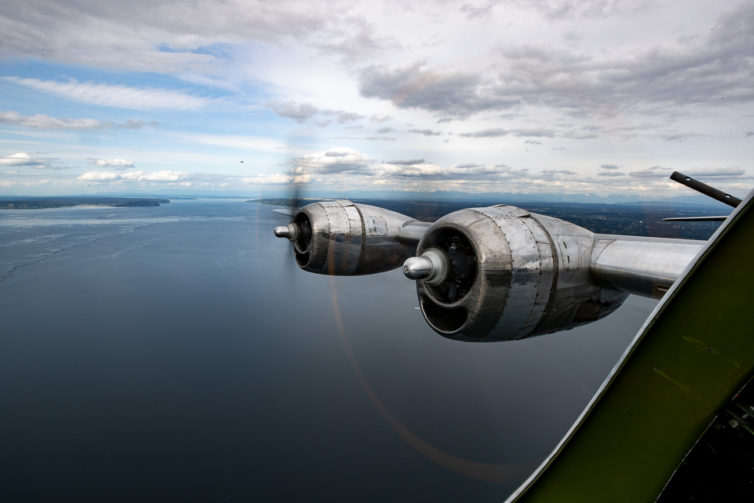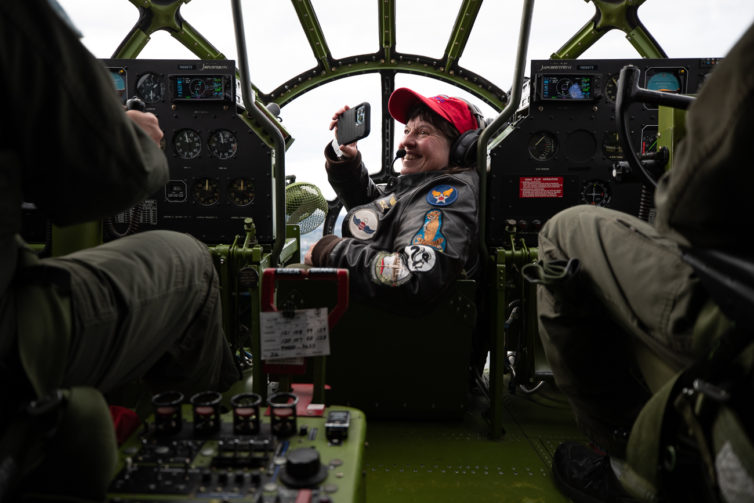
Typically we cover airlines and airliners here at AirlineReporter, but occasionally an opportunity in the non-airline[r] worlds pops up that we just can’t pass on.
So when the Museum of Flight here at our Seattle HQ announced that Doc, one of only two airworthy Boeing B-29 bombers, was planning to visit in mid-May, we jumped at the chance to see her up close. Even better, we got to take a short ride around Seattle.
The airplane arrived earlier this week (May 17). Its Star Wars-esque nose, four engines, and incredibly shiny fuselage made it easy to spot on the horizon. The pilots eased the bird onto the runway and taxied down to the Museum of Flight ramp as a crowd of onlookers gathered to watch.
While the B-29 was originally produced in Seattle, Doc is not a native Pacific Northwesterner. It was one of 1,644 B-29s built at Boeing’s Wichita plant, in Kansas, and rolled off the line in March of 1945. It never saw combat, and went on serve in radar calibration and target-towing until it was decommissioned in 1956.

It continued its service to the United States Air Force even after retirement, but instead of towing targets, it became one. The airplane spent decades soaking in the desert sun, along with the occasional bomb or bullet, on an Air Force bombing range near China Lake, California before being discovered in 1987. Restoration didn’t begin for another decade, in 1998, following a considerable amount of paperwork to pry the plane loose from the US government. Eighteen years and over 450,000 volunteer hours after that, the restoration was complete, and Doc once again took flight in 2016.
Its Seattle visit is the first for Doc, and the first B-29 visit to the area in almost eight years.

After a quick refueling – the crew had flown in from Spokane, WA – a gaggle of media were invited to board. AirlineReporter got incredibly lucky and was offered a seat in the forward compartment, right behind the pilot. Visitors and crew alike climb aboard via a ladder in the nose gear wheel well, and are deposited right into the center of the cockpit.
In service, this compartment would’ve been quite busy with five people up front. Of course there’s the two pilots and a flight engineer, plus a navigator and, with the best seat in the house, the bombardier right in the nose.

Today of course, two of those positions are no longer necessary. The navigator and bombardier seats are now open for passengers, and an additional seat was added behind the pilot to fit one more person for a total of seven up front.
Eight more are seated in back, two scanners that assist the pilots in observing wheels and flap settings, and six passengers. The two sections are connected via a long, narrow tunnel that stretches over the bomb bay. Back when it was in service, crews could traverse the two compartments in flight, but today passengers are not typically allowed to do so, mostly due to the risk of turbulence.

Access hatches to the bomb bay, located under the tunnel at either entrance, look more like submarine hatches than anything you’d typically see on an airplane. That’s because the B-29 was among the first production aircraft to be pressurized when it first flew in 1942. This gave its flight crews substantial advantages in comfort that other World War II-era bombers simply didn’t have.
The flight engineer offered a detailed explanation as he brought the four giant radial engines to life on the ramp. The roar is quite something, even from inside the airplane, and getting to watch the engineer work his magic is impressive.

As we taxi out under the call sign ‘Superfortress’ it is hard to forget that the airplane’s powerplants have a bit of a bad reputation, at least historically. The early model Wright R-3350 Duplex-Cyclone engines had a bad habit of overheating on take off. If the pilots couldn’t get the airplane airborne fast enough they could – and often did – catch on fire. If crews didn’t land fast enough the fire would spread from the engine to the wing and, well, things didn’t get better from there.
The second B-29 prototype suffered that exact problem on a seemingly routine test flight in 1943, having departed Boeing Field off the same runway we’re now on. Unfortunately the crew was unable to return safely. The airplane crashed into a neighborhood just north of the runway – not even several hundred yards from where we are now – killing 10 on board and 21 on the ground. Later advances in engine tech ironed out those early issues, saving later crews and aircraft from a similar fate.

Our takeoff, though, was thankfully comparatively uneventful, albeit thrilling. The incredible number of windows from floor to ceiling makes watching the takeoff a visual feast. It’s genuinely hard to decide what to look at: the runway, the flight engineer, or either of the pilots. It’s all fascinating.
The pilot guided the airplane to the left, threading between Boeing Field and Renton Municipal, before settling into a cruising altitude of 1,500 feet and a speed of 200mph. It’s a leisurely walk in the park for the airplane which, while in service, could hit altitude just shy of 32,000 and top speeds of over 350mph. This made it one of the faster bombers in the War, often able to fly higher and faster than enemy fighters.
Not long after setting a track north along scenic Lake Washington, the crew signals we can get up and look around. The space is not especially large, and the three of us journalists behind the pilots work to coordinate switching positions.

Much like take-off, it’s hard to decide where to look. The view out front never gets boring, with the world lazily passing by below. A small window by the navigator table has a great view of the wing and the engines, and occasionally the flight engineer offers the chance to lean over him to see out his much larger – and open – window.
The crew offers us to take a seat in the mouth of the tunnel, the top of which is graced by a small bubble window that affords fantastic views of the airplane and the area around it. Since Doc never saw combat, it didn’t have the machine gun turret that normally would’ve been here. Same goes for the turrets below and in the aft section of the airplane. The only turret that remains is the tail gunner, with a pair a inert Browning machine guns standing duty.

The interior is impeccably restored and almost immaculately clean. Of course, it’s not exactly completely vintage. The cockpit has modern navigational equipment, is ADS-B compliant (you can track her on Flightradar24 and get notifications from JetTip), and the aft compartment has a pair of TV screens with forward-facing views during flight for those in back.
Same too with many of the parts. At some point parts break and need to be replaced. The crew explains that the Air Force helps out often, allowing them to rummage through bone yards for vintage replacements where possible. When that fails, Boeing and Spirit Aerosystems often step in to help, custom-building parts and providing expertise. The airplane even has some 3D-printed parts in non-critical areas, something that the crews who first flew her back in the ’40s likely never conceived possible.
Toward the end of the flight we were lucky enough to swap for a seat in the coveted bombardier position for landing. There is no other seat like it in aviation, at least that we can think of.
The pilots greased the runway a few minutes later, and parked back where we started.
We had the chance to crawl through the tunnel after parking, and check out the aft compartment. Unlike many other warbirds, Doc’s passenger section is outfitted with actual seats. You can access the tail gunner position in flight, and those in back did, by crawling through the last ten feet or so. It’s tight, and that’s without the equipment and ammunition that would’ve been stored here during her service years.
Outside, the crew wiped her down and prepped her for a few days off before flying begins anew later this week.
Unfortunately for Pacific Northwest-based readers, flights aboard Doc during its Seattle visit are already sold out. They aren’t ruling out future flights being added if enough demand exists, though, so keep an eye on their website or give ’em a call over the weekend just in case.
If you absolutely have to fly on it and can’t make it work here, you can follow the airplane to any of its next stops on the tour. A full schedule is on their website.
Be forewarned, tickets are expensive. The least expensive seats, in the aft compartment of the airplane, go for $600. The forward compartment starts at $1,200 for the two in the cockpit and jumps to $1,500 for that sweet, sweet bombardier ride.
That’s not terribly surprising given the airplane burns $4-5,000 in oil and fuel alone per hour, according to the crew. It doubles after adding insurance, maintenance, and other costs, they said.
If that isn’t exactly in your budget, ground tours will be available Friday through the weekend; donations encouraged. Or simply pop by Boeing Field around 9am either weekend day and watch it head out for yourself.
You’ll be glad you did.